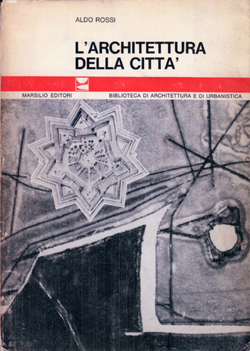The book that is issued by Marsilio publishing house in 1966 within “Polis” book series directed by Paolo Ceccarelli – written by a young architect, Aldo Rossi (Milano 1934-97) who has already acquired a wide experience as critic in virtue of his ten-year lasting participation in Ernesto Nathan Rogers’ “Casabella” editorial staff, is not, as it could be paradoxically said, the worldwide success book, the one that has been read, contrasted, hated, loved, followed as the Gospel or pointed at it as the source of all evils in architecture, in the following decades.
The book has not changed, with the exception of few editing encumbrances added along with the different issues, but interest and passion as well arising from it ended with the distortion of the book proper aims, conceived by the author both as an in progress synthesis of an extremely fertile time period as far as researches and studies are concerned and a business card to gain access to a long and lucky university career carried out among Milan, Zurich and Venice.
It would be of no sense to point out such a difference between the original reasons of an essay and the way it has been welcomed by the architects community always looking for theoretical orientation, if such an essay weren’t, still today, one of the very few basic texts written from the inside of architectural culture and practice in the last forty-five years.
And this mainly because all the matters mentioned and partly developed by Rossi are still waiting for further consideration that the author himself deemed necessary by starting from the idea that his essay was nothing more than “a sketch of an established urban theory”.
For this reason we can consider this book in the same way as one of those unfinished works really beloved by the author who continuously comes back to it through his whole architect career with the knowledge that the subject of his research, in this case the city and more precisely the historical city, cannot be explained or simply represented by final considerations or acts nor interpreted through unchanging schemes.
Actually the city is intended as a work of art as well as a changeable substance and it is for this reason that the usual time parameters and the normal space definitions are inadequate to explain its global meaning.
In designing such a structure of city, Rossi takes back all the data found by all those geographers, anthropologists, economists or historians who have focused their attention on everything concerning the urban world but, at the same time, he is strongly determined to use every single datum according to a point of view deeply rooted within architecture culture.
Rossi’s essay does not deal with cities in general but, in particular, it deals with everything representing all that can be clearly seen, or the formal aspect of the city itself.
In this book the Author tries to investigate the life of urban shapes by taking it as the true specific phenomenon peculiarity, the only one able to explain its particular, synthetic nature, beyond any sort of social, economic and functional point of view and identified as essential though partial.
Rossi’s approach is, at the same time, extremely selective and widely inclusive.
As a matter of fact, he looks at the whole variety of reasons contributing to the definition of the phenomenon that is the object of the study, but, on the other hand he takes them into account mainly in terms of physical impact and with respect to this, he focuses on some events.
Such an approach is not intended to face the case of single city, but the case of the cities, or, that is better, “the soul of the cities”, to recall the title of the chapter devoted to this phenomenon in Der Untergang des Abendlandes (1918-22) by Oswald Spengler, published in Italy in 1957 and known to Rossi since the time of his working experience at “Casabella” editorial staff.
Maybe the highest value of L’architettura della città lies in its ability to look at things that are under everybody’s own nose with different eyes, by restoring the global dignity of a knowledge like the one the architects own, that is extremely constrained, as far as the years in which it is conceived are concerned, in a mainly professional domain.
The book is at the same time the essay of an academic and the design of an architect.
By standing firm on his point of view as an architect, he manages to make clear his own original contribution that in the following years would modify so much the world architecture culture attitudes and ways of being thus drawing the attention to the phenomenon of the city as an essential background of both architect knowledge and profession.
Alberto Ferlenga
More info at:
http://www.iuav.it/Ateneo-cal/2011/10/architettu/architettu/index.htm
